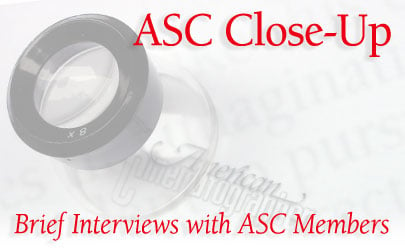 |
||||
 |
|
|||
| Ralph Woolsey, ASC |
|
|||
When you were a child, what film made the strongest impression on you? Movies were silent until I was well into high school, but going to a Saturday Western was a big deal. Yet I barely remember Ken Maynard and Hopalong Cassidy because I was a piano student, captivated by the Mighty Wurlitzer theater organ that accompanied the derring-do on the screen. I’ve been an organ aficionado ever since. Which cinematographers, past or present, do you most admire? It goes beyond personal admiration for these artists whose works have inspired, instructed and entertained me, as well as many students, over the years: ASC members Karl Freund, Arthur Miller, John Toll, Laszlo Kovacs, Conrad Hall, Karl Struss, Russell Carpenter, Richard Edlund, Roger Deakins, Michael Ballhaus, Jack Green, Chris Menges, Rodrigo Prieto, Owen Roizman, Giuseppe Rotunno, Eduardo Serra, Vittorio Storaro, William Clothier, Gregg Toland, Arthur Edeson, Ted McCord, Sven Nyqvist, Joseph Walker, Vilmos Zsigmond, William Fraker, Harry Stradling and Robert Surtess; BSC members Jack Cardiff, Guy Green and Freddie Young; AFC members Raoul Coutard and Bruno Delbonnel; Gabriel Figueroa, AMC; Tonino Delli Colli, AIC; Pawel Edelman, PSC; Georges Perinal; Eduard Tisse; Billy Bitzer; Robert Krasker, and Robert Flaherty. What sparked your interest in photography? In high school, my interest in wildlife was shared by an amateur-photographer friend who really got me started. Some 10 years later, I became the first official wildlife filmmaker for the state of Minnesota. Where did you study and/or train? I moved from the Twin Cities area to Fargo, where I stayed with an uncle, worked for the Ford Motor Co., and moonlighted for a local photographer, learning from the ground up. Who were your early teachers or mentors? My generous photographer friends and a Minneapolis dealer who kept me in a succession of cameras with which I became quite skillful. After several years of this, I left for the University of Minnesota, intent on becoming a zoologist. The school had a marvelous photo lab staffed by professionals who did every conceivable kind of photography. Later, when they offered me a technician job, I changed direction to learn from the pros. In a few years, I began to produce films for the state. What are some of your key artistic influences? The work of Henri Cartier-Bresson, Ansel Adams, Pirie MacDonald, Edward Steichen, Alfred Stieglitz, Edward Weston and the Impressionist painters. How did you get your first break in the business? The best, but not the first, came in late 1957, one year after I became an ASC member. I had been freelancing for more than 10 years and was an instructor at the University of Southern California school of cinema. I got a call from Warners to stand in for the cinematographer on a new TV show; he and the director had become ill before shooting began, and Howard W. Koch took over as director. I was a devotee of my friend Arthur Miller’s camera and lighting style, which seemed just right for this new show, called Maverick. It was one of the first TV shows done at Warners, and the studio was concerned about its look and that of its new star, Jim Garner. But all went smoothly — we finished early every day, which was unheard of. Most importantly, Howard, Jim and the art director were very happy with the dailies. Three or four days into the episode, the studio offered me a five-year contract. I was in the right place at the right time and was qualified for the job, but I owed much to the director’s expertise and good words. What has been your most satisfying moment on a project? Screening the successful use of breakthrough (even daring!) new technology. Have you made any memorable blunders? Never. I’m a firm believer in fallback planning and track covering. What’s the best professional advice you’ve ever received? “Never look back.” — Karl Freund. What recent books, films or artworks have inspired you? I’ve been aware of marvelous work by photojournalists over the past couple of years. Aided by image-stabilized optics and digital sophistication, they have given us intimate inside views of events ranging from sports to distant conflicts. Do you have any favorite genres, or genres that you would like to try? I’m retired, but if it can be done in Photoshop, there’s a chance. If you weren’t a cinematographer, what might you be doing instead? Second choice would be a career as a serious geographer, traveling with state-of-the-art photo equipment and an unlimited expense account. Which ASC cinematographers recommended you for membership? Arthur Miller and George Folsey. How has ASC membership impacted your life and career? In a few months I’ll be a 50-year member. From the moment I put the new membership plaque on my USC office wall, I was treated with respect and awe, for the prestige and sanctity of our Society were legendary. Although I had been an occasional guest at our storied Clubhouse, becoming a member was life changing, with new friendships and opportunities to learn from older and wiser heads. Many of the real giants of our profession were still active, and I was awestruck by their mere presence. But later opportunities to serve on committees and the board brought everyone together on common ground. In a tangible way, my career was influenced and aided by associate members, some of whom are good friends to this day. A technician at heart, I reveled in testing and using cutting-edge stuff provided by those guys. Today’s ASC Technology Committee is well aware of the velocity of change in imaging technology. We are privileged to have this well-recognized and dedicated group. |
|
|||
|
<< prev |
||||
|
|
|
|
|
|


